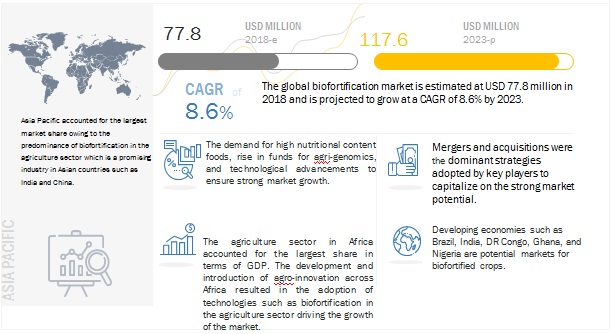The report “Biofortification Market by Crop (Sweet Potato, Cassava, Rice, Corn, Wheat, Beans, and Pearl Millet), Target Nutrient (Zinc, Iron, and Vitamins), and Region (Latin America, Africa, and Asia Pacific) – Global Forecast to 2023 “, is estimated at USD 78 million in 2018, and it is projected to grow at a CAGR of 8.6% from 2018 to reach USD 118 million by 2023. Biofortified crops are usually sweet potato, cassava, rice, corn, wheat, beans, pearl millet, and other crops such as tomato, banana, sorghum, and barley. The growth of the biofortification market is driven by the rising demand for high nutritional content in food.

By target nutrient, the biofortification market has been segmented into iron, zinc, vitamins, and others, such as â-carotene, amino acids, and proteins. The iron segment is estimated to account for the largest share in 2018. Iron is a micronutrient, which is required by plants in lesser amounts than primary or secondary micronutrients. It is a constituent of several enzymes and some pigments, and assists in nitrate and sulfate reduction and energy production within the plant.
Download PDF Brochure: https://www.marketsandmarkets.com/pdfdownloadNew.asp?id=38080924
By crop type, the sweet potatoes segment accounted for the largest market in the market in 2018. The demand for biofortified crops such as sweet potato and cassava has increased with the rising technological advancements to increase the nutrient content, particularly in orange-fleshed sweet potato (OFSP). Sweet potato is recognized as an important source of energy in the human diet for centuries owing to its high carbohydrate content. However, its vitamin A content from carotene only became recognized over the past century.
Regionally, Asia Pacific is the dominant region in the biofortification market. Biofortification has strong growth potential in agriculture, and it also improves the nutrition content in food. Countries such as India and China are agrarian in nature and have consequently improved the opportunities for use and potential for biofortification.
Sweet potato segment to dominate the biofortification market, by crop, in 2018
The sweet potato segment is estimated to hold the largest share of the global biofortification market in 2018. The demand for biofortified crops such as sweet potato and cassava has increased with the rising technological advancements to increase the nutrient content, particularly in orange-fleshed sweet potato (OFSP). Sweet potato is recognized as an important source of energy in the human diet for centuries owing to its high carbohydrate content. However, its vitamin A content from carotene only became recognized over the past century.
Request for Customization: https://www.marketsandmarkets.com/requestCustomizationNew.asp?id=38080924
Asia Pacific to be the dominant region in the biofortification market in 2018
The Asia Pacific is the dominant region in the biofortification market. Biofortification of crops has strong growth potential in agriculture, and it also improves the nutrition content in food. The biofortification market has grown considerably over the last five years, and this trend is expected to continue in the near future. The growing consumer demand for high nutritional content in food is projected to fuel the demand for biofortified crops, globally. Since the last decade, many countries in the Asia Pacific region have banned the usage of GM technology, and the researchers are opting to adopt biofortified crops as a key to unlock the region’s food production.
This report includes a study of marketing and development strategies along with the product portfolios of the leading companies in the biofortification market. It also includes the profiles of leading companies such as Bayer (Germany), Syngenta (Switzerland), Monsanto (US), and DowDuPont (US).